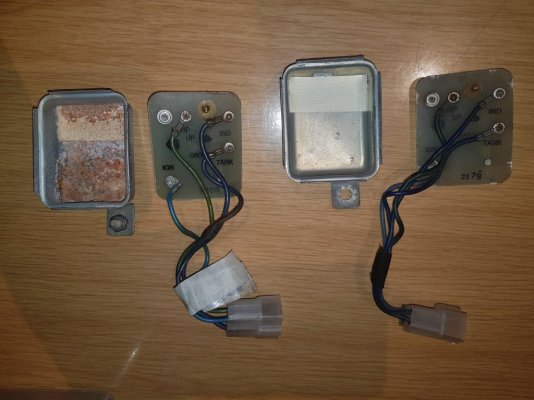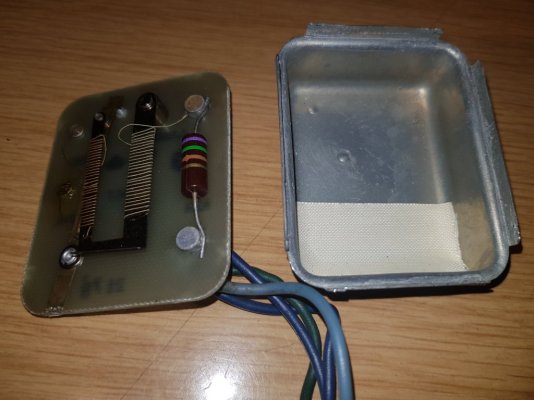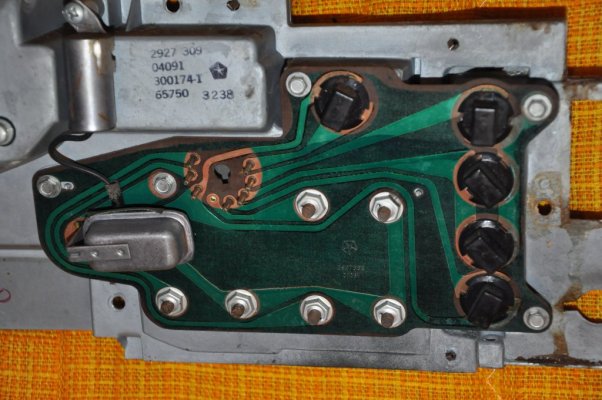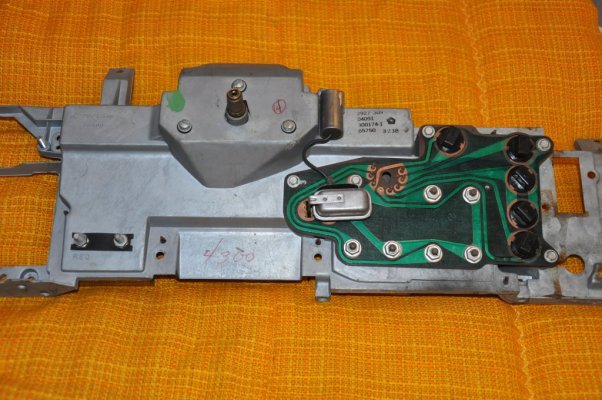To clean the greasy vinyl elastomer that oozes over time from the dashpad, I just use a normal grease cutter such as Purple Power or similar in a wet cloth and wipe it down. Afterwards I put a vinyl lotion treatment on it to preserve its lustrous look and feel such as one from 3M. Whatever grease cutter you use, try it on a portion of the dashpad such as under the lower ledge to make sure it doesn't affect the pad in any negative way. The various dashpads Chrysler made were not all alike and the 1969-70 dashpads seem to have a lot of the elastomer in them while others seem to have far less without an oozing problem and they tended to crack very early in the life of the car if exposed to the sun any significant amount of time especially.@jet1969 — with Leatherique, you should be able to get the leather back into a shape that you like.
The C-Y dashes seldom crack (good). The goop that protects against cracking tends to get out over time (not good), it but can get cleaned up (good).
@saforwardlook has commented (in another thread, 1-2 years ago) about how to get the imperial dashes cleaned up. Let me know if you can’t find it.
You are using an out of date browser. It may not display this or other websites correctly.
You should upgrade or use an alternative browser.
You should upgrade or use an alternative browser.
1971 Imperial 2 door restauration
- Thread starter jet1969
- Start date
boostedvan
Active Member
And look at that. The one BC resident whom I forgot to tag, is the one who knows the car. Sorry @boostedvan got the omission!
PS: might you have pics of the car over the years you’ve known it?
I have a couple pics back from 2015 of the car.
I am flabbergasted....Incredible this forum. It's a small world here in c body-imperial-world
Thanks Carsten, I will let you know if it doesn't work out.the facefuck group fuselage germany blabla accepts foreign members, too.
But it is only for owners
If they haven't let you in yet: Give me a note with your FB name. I know the guys running the group so I can push them to let you in
Carsten
Nice to hear you know the car. Is it possible to have more information about the detailed history of the car to know the "soul"of the car. More or less what has been done. I saw modifications on the suspension. The interior/exterior and all the electrical stuff needs a lot of attention and parts which are missing. Maybe you can help me out with some information?I know the car very well. You purchased it from a buddy of mine. The previous owner had the car for years, and put a lot of money in it. I tried to buy it a few times over the years. At some point the car got hit down one side. He contacted my buddy looking for parts and he ended up buying the car off of him. Originally a GF9 car with green interior. Has a nicely built 440 under the hood.
If I didn't have my plate full of 300's, I would've bought the car. Nice score on it!
Nice to hear you know the car. Is it possible to have more information about the detailed history of the car to know the "soul"of the car. More or less what has been done. I saw modifications on the suspension. The interior/exterior and all the electrical stuff needs a lot of attention and parts which are missing. Maybe you can help me out with some information?I know the car very well. You purchased it from a buddy of mine. The previous owner had the car for years, and put a lot of money in it. I tried to buy it a few times over the years. At some point the car got hit down one side. He contacted my buddy looking for parts and he ended up buying the car off of him. Originally a GF9 car with green interior. Has a nicely built 440 under the hood.
If I didn't have my plate full of 300's, I would've bought the car. Nice score on it!
Hi Martin@jet1969 Joow , hoe is het vinyl van je dash....nog mooi of scheuren ?
Heb er nog eentje die redelijk mooi is.....( Groen ).
Grtn Martin.....( Nijverdal )
Nice to hear a dutch fuselage c body fan. We might have contact in dutch ?
ceebuddy
Senior Member
1,430 total.Do you know How many of these 1971 chrysler imperial 2 doors have been made?
Thanks very much for the research, seems not a lot… seek a needle in a haystack for parts….I need to check at Murray’s for some spare parts . Interior or exterior still a lot missing or damaged. ( trims, doorpanel, switches, lights)1,430 total.
A lot of parts are interchangeable with 1969-1971 Imperial and even Chryslers.
Have you seen the 1970 Imperial that's getting parted out in the Netherlands right now? Maybe he does have some parts you need!?
And/or the 1970 Imperial parts car in Canada
Have you seen the 1970 Imperial that's getting parted out in the Netherlands right now? Maybe he does have some parts you need!?
For Sale - Imperial Lebaron 1970 parting out Europe
Parting out my Imperial, 1970 Lebaron. Car is in the Netherlands, Europe. Small or light stuff can be shipped overseas. Attached fender tag Motor and trans already gone Parts starting at $10,00 Windscreen smashed, unfortunately. Clean US title
www.forcbodiesonly.com
And/or the 1970 Imperial parts car in Canada
For Sale - Parting 70 imperial 4dr
parting a 70 imperial 4dr. Pretty clean car. Says 70000~ish miles. Green on green. let me know what your looking for. I am in Bc Canada. can’t ship big stuff, Sorry too much hassle. Motor trans rad and third member gone. Pm me with what you need. PayPal only or etranfer if your...
www.forcbodiesonly.com
Thanks Ayilar for all the details. Lately I was getting all the stuff out of my garage so the "boat" can get in . It just fits in but can I open the doors to gt out. Becomes a "Duke of hazard"thing to get in and out of the car. I have made a list (not limitative) of all the interior things to do, so i can contact salvage yards in the US if the have spare parts in the right colour. Do you have a link of the interiour and exteriour (colour)code book of which you sent two links. Would be great@jet1969 -- thank you for posting the VIN and fender tags of YM23T1C101779 -- the car is an early build, with a SBD of Aug. 18, 1970.
If I see correctly, the car has a B VON so would have been a Canadian-market car: do you have info on the car's history? @marko @69CoronetRT @kmccabe56
I also see that the color is GF9 Avocado Poly -- very dark green but not black! In fact, with GF9 paint, V1F green vinyl top, and MRF7 Green Leather (Buckets) interior, your car qualifies as a @Triple Pickle ! I look forward to better photos of the top and interior.
I'll step in if I may ;)
Hamtramck historical got all your looking for. It's a great source!
The 1970 Hamtramck Registry - 1971 Chrysler Color & Trim Book - Imperial
The 1970 Hamtramck Registry - 1971 Paint Chip Charts
Hamtramck historical got all your looking for. It's a great source!
The 1970 Hamtramck Registry - 1971 Chrysler Color & Trim Book - Imperial
The 1970 Hamtramck Registry - 1971 Paint Chip Charts
Great source!! Thanks a lotI'll step in if I may ;)
Hamtramck historical got all your looking for. It's a great source!
The 1970 Hamtramck Registry - 1971 Chrysler Color & Trim Book - Imperial
The 1970 Hamtramck Registry - 1971 Paint Chip Charts
When you take the instrument cluster out of the dash you will see the rectangular shaped voltage limiter on the backside in the printed circuit board and attached with that limiter is the noise suppressor. Just pull the factory limiter with some prongs on it along with the noise suppressor that is combined with the factory noise suppressor and replace them both with a new solid state voltage limiter.
The photo of the recommended new replacement printed circuit board above has three slotted insertion points for the three tabs on the factory voltage limiter and those same slots accommodate the noise suppressor too - just yank both items and replace them both with the recommended solid state limiter that attaches in those same slots. Then you will likely be good to go........................
Is the limiter located there or is it like my 300 where the limiter is built into the "low fuel warning" relay mounted near the passenger side ashtray?
The FSM is a bit ambiguous about it, although it does say the Imperial will have that low fuel warning as standard (optional on mine) and the limiter is part of that system.
Looks like this:
Picture stolen from the intrawebs. Yes, that's the same piece used in a C-body.
The relay you are showing John when used on an Imperial is used for the sentry signal system for the same purpose as you indicated - to monitor and detect when any of the gauges is showing too low of a reading and not just the low fuel level. I am not sure though whether it detects when an engine is running too hot on an Imperial since I have never let one of mine get too hot. The limiter on the back side of the printed circuit board limits excessive voltage to any of the gauges, I believe when it is functioning correctly. When the factory limiter isn't functioning properly and allows too much current, that situation will likely fry one or more of the gauges then. The solid state limiters will not allow that to happen, another benefit of the better device. When I have a cluster out of one of my cars, I always replace the factory limiter with the solid state ones to preclude having to replace one of my gauges down the road.
That relay is also located in the same place on an Imperial as on your 300 with that option.
On my car, there are both, the limiter on the circuit board and the Low Fuel Warning Relay box present!Yes, but my 300 only has (had) the one voltage limiter and there was no limiter on the rear of the dash. It would seem funny to have two voltage limiters.
I've never owned an Imperial so I have no first hand knowledge.
Here's a better pic of the internals, showing the voltage limiter.
When I installed my Meter Match with a low fuel warning, I went with a cheap solid state regulator like this. It also provides a 5 volt source to charge my phone!
I did this when I found out some Ford guys use this. Fords have almost the same gauge setups.
I replaced my original regulator on the circuit board with a modern silid state one.
It came with a resistor in the package that has to be soldered onto the circuit board. I can make a picture of that later if needed.
Hope that helps.




On my car, there are both, the limiter on the circuit board and the Low Fuel Warning Relay box present!
I replaced my original regulator on the circuit board with a modern silid state one.
It came with a resistor in the package that has to be soldered onto the circuit board. I can make a picture of that later if needed.
Hope that helps.
View attachment 586772View attachment 586773View attachment 586774View attachment 586775
In thinking about this, it occurred to me that the Imperial has more gauges than my 300. The 300 has an ammeter and a gas gauge. Oil and temperature are lights. The Imperial has ammeter, gas, temperature and oil pressure gauges.
I found this in my '70 FSM and I see that there is two voltage limiters. One is in the low fuel relay and that feeds voltage to the gas gauge and the other is mounted on the rear of the dash and feeds voltage to the oil pressure and temperature gauges.
I still don't understand why they would use two limiters, but here we are...
So, you could have a fuel gauge fail and because they used that same limiter in E-bodies, it isn't going to be cheap if you want to use OEM parts. There are ways around it... using a 7805 "chip" like Ehrenberg does in step #9 here: Vintage Chrysler electrical repairs and updates (part 2) would be a good choice.
Similar threads
- Replies
- 2
- Views
- 1K
- Replies
- 0
- Views
- 573
- Replies
- 7
- Views
- 2K
- Replies
- 11
- Views
- 2K
















